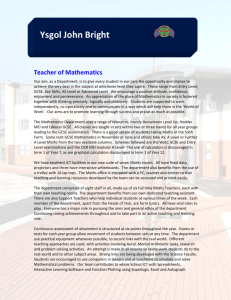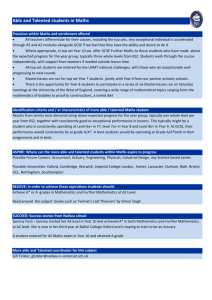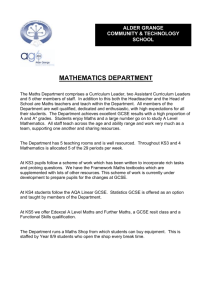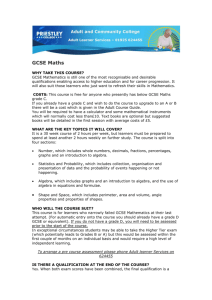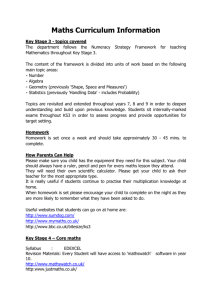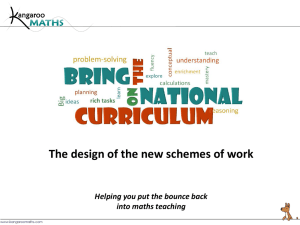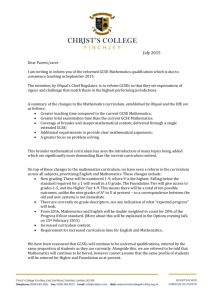3-Key_differences_in_L2_FS_and_GCSE_maths
advertisement
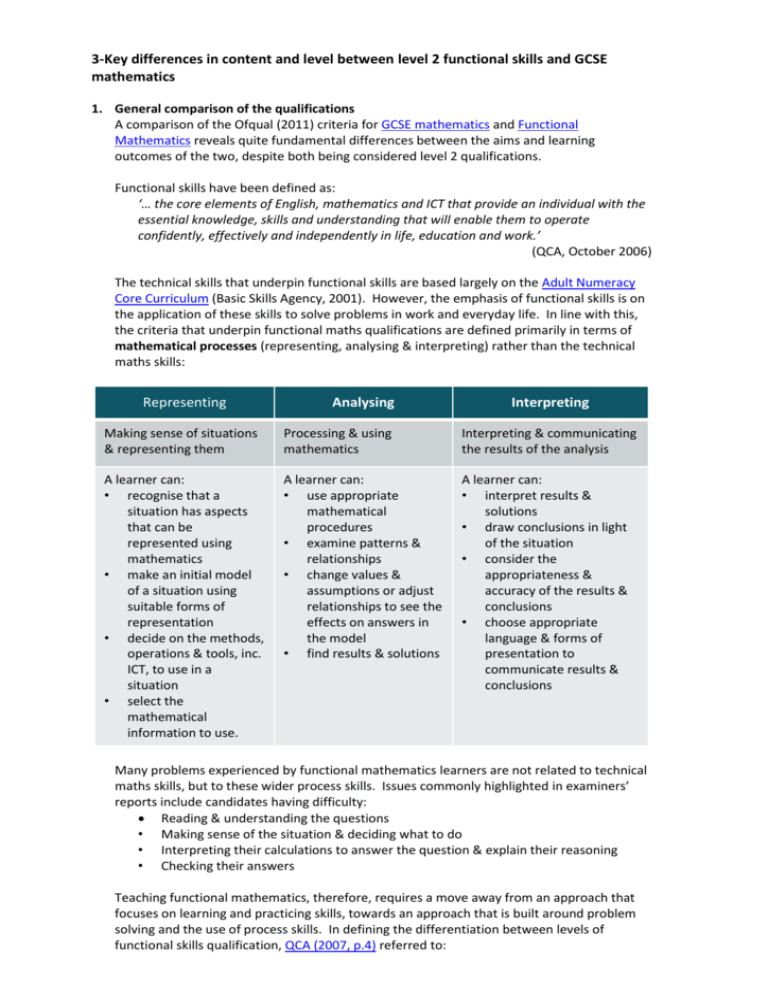
3-Key differences in content and level between level 2 functional skills and GCSE mathematics 1. General comparison of the qualifications A comparison of the Ofqual (2011) criteria for GCSE mathematics and Functional Mathematics reveals quite fundamental differences between the aims and learning outcomes of the two, despite both being considered level 2 qualifications. Functional skills have been defined as: ‘… the core elements of English, mathematics and ICT that provide an individual with the essential knowledge, skills and understanding that will enable them to operate confidently, effectively and independently in life, education and work.’ (QCA, October 2006) The technical skills that underpin functional skills are based largely on the Adult Numeracy Core Curriculum (Basic Skills Agency, 2001). However, the emphasis of functional skills is on the application of these skills to solve problems in work and everyday life. In line with this, the criteria that underpin functional maths qualifications are defined primarily in terms of mathematical processes (representing, analysing & interpreting) rather than the technical maths skills: Representing Analysing Interpreting Making sense of situations & representing them Processing & using mathematics Interpreting & communicating the results of the analysis A learner can: • recognise that a situation has aspects that can be represented using mathematics • make an initial model of a situation using suitable forms of representation • decide on the methods, operations & tools, inc. ICT, to use in a situation • select the mathematical information to use. A learner can: • use appropriate mathematical procedures • examine patterns & relationships • change values & assumptions or adjust relationships to see the effects on answers in the model • find results & solutions A learner can: • interpret results & solutions • draw conclusions in light of the situation • consider the appropriateness & accuracy of the results & conclusions • choose appropriate language & forms of presentation to communicate results & conclusions Many problems experienced by functional mathematics learners are not related to technical maths skills, but to these wider process skills. Issues commonly highlighted in examiners’ reports include candidates having difficulty: Reading & understanding the questions • Making sense of the situation & deciding what to do • Interpreting their calculations to answer the question & explain their reasoning • Checking their answers Teaching functional mathematics, therefore, requires a move away from an approach that focuses on learning and practicing skills, towards an approach that is built around problem solving and the use of process skills. In defining the differentiation between levels of functional skills qualification, QCA (2007, p.4) referred to: The complexity of the situation and activities The technical demand (i.e. mathematical skills) associated with these activities A learner’s level of familiarity with the task or activity The level of independence with which a learner can complete the activity In other words, technical maths skills are only one element in the assessment of functional mathematics. Since 2011, the GCSE mathematics specifications have been broadened to include outcomes that enable learners to ‘acquire and use problem-solving skills’ and ‘select and apply mathematical techniques and methods in mathematical, everyday and real-world situations’ (Ofqual, 2011, p.3). However, the subject content still focuses primarily on the technical skills of mathematics, rather than their application. The differing focus of the two qualification means that it is not a straightforward matter to say that one qualification is more difficult then the other. Anecdotal evidence suggests that many adult learners find functional mathematics easier than more traditional GCSE maths – possibly because of their greater life experience and application of maths within that. In contrast, some 16-19 year olds, having passed GCSE maths at school, have found the process skills of functional maths more challenging. Because functional mathematics questions are always set in context, often involving quite lengthy written questions, they often present barriers to ESOL learners and those with poor literacy skills. 2. Comparison of the mathematical content Appendix A provides a direct comparison of the technical maths skills involved in GCSE mathematics with those involved in functional skills, according to the respective Ofqual (2011) criteria. It is immediately obvious that technical skills required are far more specific in the GCSE criteria, while for functional mathematics, broad statements of coverage are used, which leaves far more to scope for awarding body interpretation. It is also obvious that the technical maths skills required by GCSE are far wider and more complex than those needed for functional mathematics. Specifically, the following technical content present in foundation tier GCSE is not evident in functional mathematics criteria at level 2: Concepts of factors, multiples & prime numbers (though these might still be useful concepts for functional maths) Index notation Almost all aspects of algebra (other than use of basic formulae) Most aspects of geometry More technical aspects of statistics (e.g. correlation, comparing distributions) Almost all aspects of probability 3. Mathematics within vocational areas The situation becomes more complex with the issue of embedding mathematics within work & vocational contexts. It is undoubtedly true that some vocational areas (e.g. engineering) are more mathematically rich than others (e.g. art & design). In addition to this: Mathematical skills vary widely between vocations - e.g. construction requires skills in measuring lengths, calculating areas, interpreting scale drawings; catering requires skills in measuring weight, capacity & temperature. Vocational (& social) practices are often very different to ‘classroom’ maths – maths is often applied in very different ways to how it is taught in the classroom – e.g. a carpet fitter doesn’t work out quantities in the way shown in a school text book. (In theory, this aligns better with functional skills than GCSE) Some vocational areas require maths skills (or quasi maths skills) that do not feature within any maths qualification – e.g. coding for the IT industry. Appendix A: Comparison of the Ofqual mathematical subject content of GCSE Mathematics & Functional Mathematics level 2 Number & algebra GCSE add, subtract, multiply and divide any number; understand and use number operations and the relationships between them, including inverse operations and hierarchy of operations order rational numbers use the concepts and vocabulary of factor (divisor), multiple, common factor, highest common factor, least common multiple, prime number and prime factor decomposition use the terms square, positive and negative square root, cube and cube root use index notation for squares, cubes and powers of ten use index laws for multiplication and division of integer, fractional and negative powers interpret, order and calculate with numbers written in standard index form understand equivalent fractions, simplifying a fraction by cancelling all common factors add and subtract fractions use decimal notation and recognise that each terminating decimal is a fraction recognise that recurring decimals are exact fractions, and that some exact fractions are recurring decimals understand that ‘percentage’ means ‘number of parts per 100’ and use this to compare proportions interpret fractions, decimals and percentages as operators use percentage, repeated proportional change understand and use direct and indirect proportion use ratio notation, including reduction to its simplest form and its various links to fraction notation divide a quantity in a given ratio use surds and π in exact calculations calculate upper and lower bounds approximate to specified or appropriate degrees of accuracy including a given power of ten, number of decimal places and significant figures use calculators effectively and efficiently, including statistical and trigonometrical functions distinguish the different roles played by letter symbols in algebra, using the correct notation distinguish in meaning between the words equation, formula, identity and expression manipulate algebraic expressions by collecting like terms, by multiplying a single term over a bracket, and by taking out common factors, multiplying two linear expressions, factorising quadratic expressions including the difference of two squares, and simplifying rational expressions set up and solve simple equations including simultaneous equations in two unknowns Functional Mathematics level 2 Carry out calculations with numbers of any size in practical contexts, to a given number of decimal places Understand and use positive and negative numbers of any size in practical contexts Understand and use equivalences between fractions, decimals and percentages Understand, use and calculate ratio and proportion, including problems involving scale Learners consider the appropriateness and accuracy of results and conclusions (Process Skills) (Implicit in process skills to some extent) solve quadratic equations derive a formula, substitute numbers into a formula and change the subject of a formula solve linear inequalities in one or two variables, and represent the solution set on a number line or suitable diagram use systematic trial and improvement to find approximate solutions of equations where there is no simple analytical method of solving them generate terms of a sequence using term-to-term and position-to-term definitions of the sequence use linear expressions to describe the nth term of an arithmetic sequence use the conventions for coordinates in the plane and plot points in all four quadrants, including using geometric information recognise and plot equations that correspond to straight-line graphs in the coordinate plane, including finding gradients understand that the form y = mx + c represents a straight line and that m is the gradient of the line and c is the value of the y-intercept understand the gradients of parallel lines find the intersection points of the graphs of a linear and quadratic function, knowing that these are the approximate solutions of the corresponding simultaneous equations representing the linear and quadratic functions draw, sketch, recognise graphs of simple cubic functions, the reciprocal function y = x1 with x0, the function y = k≠ x for integer values of x and simple positive values of k, the trigonometric functions y = sin x and y = cos x construct the graphs of simple loci construct linear, quadratic and other functions from real-life problems and plot their corresponding graphs discuss, plot and interpret graphs (which may be non-linear) modelling real situations generate points and plot graphs of simple quadratic functions, and use these to find approximate solutions Understand and use simple formulae and equations involving one- or twostep operations Geometry & measures GCSE recall and use properties of angles at a point, angles at a point on a straight line (including right angles), perpendicular lines and opposite angles at a vertex understand and use the angle properties of parallel and intersecting lines, triangles and quadrilaterals calculate and use the sums of the interior and exterior angles of polygons recall the properties and definitions of special types of quadrilateral, including square, rectangle, parallelogram, trapezium, kite and rhombus recognise reflection and rotation symmetry of 2D shapes understand congruence and similarity use Pythagoras’ theorem in 2D and 3D use the trigonometrical ratios and the sine and cosine rules to solve 2D and 3D problems distinguish between centre, radius, chord, diameter, circumference, tangent, arc, sector and segment understand and construct geometrical proofs using circle theorems use 2D representations of 3D shapes describe and transform 2D shapes using single or combined rotations, reflections, translations, or enlargements by a positive scale factor then use positive fractional and negative scale factors and distinguish properties that are preserved under particular transformations use and interpret maps and scale drawings understand and use the effect of enlargement for perimeter, area and volume of shapes and solids interpret scales on a range of measuring instruments and recognise the inaccuracy of measurements convert measurements from one unit to another make sensible estimates of a range of measures understand and use bearings understand and use compound measures measure and draw lines and angles draw triangles and other 2D shapes using a ruler and protractor use straight edge and a pair of compasses to do constructions construct loci calculate perimeters and areas of shapes made from triangles and rectangles and other shapes find circumferences and areas of circles calculate volumes of right prisms and of shapes made from cubes and cuboids calculate the area of a triangle using . ab sin C solve mensuration problems involving more complex shapes and solids Functional Mathematics level 2 Recognise and use 2D representations of 3D objects Understand, use and calculate ratio and proportion, including problems involving scale Use, convert and calculate using metric and, where appropriate, imperial measures Construct geometric diagrams, models and shapes Find area, perimeter and volume of common shapes Statistics & Probability GCSE understand and use statistical problem solving process/handling data cycle identify possible sources of bias design an experiment or survey design data-collection sheets, distinguishing between different types of data design and use two-way tables for discrete and grouped data produce charts and diagrams for various data types calculate median, mean, range, quartiles and inter-quartile range, mode and modal class extract data from printed tables and lists interpret a wide range of graphs and diagrams and draw conclusions look at data to find patterns and exceptions recognise correlation and draw and/or use lines of best fit by eye, understanding what these represent compare distributions and make inferences compare distributions and make inferences; understand and use the vocabulary of probability and the probability scale understand and use estimates or measures of probability from theoretical models (including equally likely outcomes), or from relative frequency list all outcomes for single events, and for two successive events, in a systematic way and derive related probabilities identify different mutually exclusive outcomes and know that the sum of the probabilities of all these outcomes is 1 know when to add or multiply two probabilities: if A and B are mutually exclusive, then the probability of A or B occurring is P(A) + P(B), whereas if A and B are independent events, the probability of A and B occurring is P(A) × P(B) use tree diagrams to represent outcomes of compound events, recognising when events are independent compare experimental data and theoretical probabilities understand that if they repeat an experiment, they may – and usually will – get different outcomes, and that increasing sample size generally leads to better estimates of probability and population characteristics Functional Mathematics level 2 Collect and represent discrete and continuous data, using ICT where appropriate Use and interpret statistical measures, tables and diagrams, for discrete and continuous data, using ICT where appropriate Use statistical methods to investigate situations Use probability to assess the likelihood of an outcome
